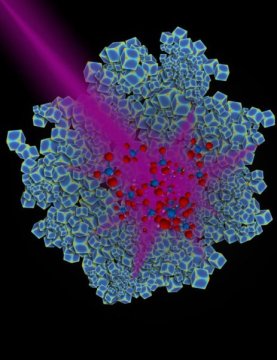Having identified a catalyst that can do this vital chemistry using ultraviolet light, the group now expects to develop a version that would run on natural sunlight, a potential boon to alternative energy. Scientists have long sought an effective, light-driven catalyst to power this reaction that could help diminish the growing levels of carbon dioxide in our atmosphere by altering it into methane, a key building block for numerous sorts of fuels.
Not just are the rhodium nanoparticles made more effective when illuminated by light, they have the advantage of strongly favouring the formation of methane rather than an equal mix of methane and undesirable side-products such as carbon monoxide. Such strong ‘selectivity’ of the light driven catalysis may also extend to other vital chemical reactions, the scientists say.
“The truth that you can use light to influence a particular reaction pathway is highly exciting,” says Jie Liu, the George B. Geller lecturer of chemistry at Duke University. “Such discovery will truly advance the understanding of catalysis.”

Despite being one of the rarest elements on Earth, rhodium plays a surprisingly vital role in our everyday lives. Tiny amounts of the silvery grey substance are employed to speed up or ‘catalyze’ a range of core industrial procedures, including those that make drugs, detergents and nitrogen fertilizer, and they even play a crucial role breaking down toxic pollutants in the catalytic converters of our cars.
Rhodium boosts such reactions with an added boost of energy that usually comes in the form of heat as it is conveniently produced and absorbed. But, high temperatures also result in problems, such as shortened catalyst lifetimes and the unwanted synthesis of undesired products.
In the past decades, researchers have explored novel and useful methods that light can be employed to add energy to bits of metal shrunk down to the nanoscale, a group called as plasmonics. “Efficiently, plasmonic metal nanoparticles function like antennas that absorbs visible or ultraviolet light very effectively and can do a range of things like generate robust electric fields.” says Henry Everitt, an adjunct lecturer of physics at Duke and senior research scientist at the Army’s Aviation and Missile RD&E Centre at Redstone Arsenal, AL.
“For the last couple of years there has been identification that such property might be applied to catalysis.” Xiao Zhang, a graduate student in Jie Liu’s Lab, synthesized rhodium nanocubes that were the optimal size for absorbing near ultra-violet light. He then placed small volumes of the charcoal coloured nanoparticles in the chamber.
“Our discovery of the unique way light can effectively, selectively influence catalysis came as a result of an on-going association between theorists and experimentalists,” says Liu. “Lecturer Weitao Yang’s team in the Duke Chemistry department offered critical theoretical insights that helped us comprehend what was happening. Such sort of analysis can be applied to numerous vital chemical reactions.”
Filed Under: News


Questions related to this article?
👉Ask and discuss on Electro-Tech-Online.com and EDAboard.com forums.
Tell Us What You Think!!
You must be logged in to post a comment.